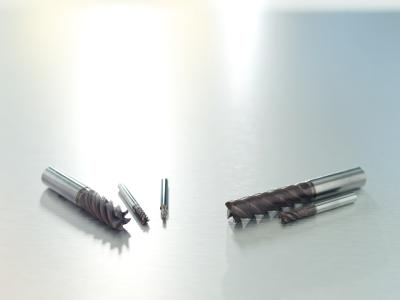
Shops that struggle to maximize end-mill tool life when machining tough materials can now achieve 25 to 40 percent longer life with new Jabro-Solid2 JS750 endmills from Seco Tools. Designed specifically for the aerospace sector, the new JS754 and JS755 tools provide cost-effective high performance to tackle that industry’s challenging materials, including ISO M (stainless steel) and S (heat-resistant superalloys and titanium).
The JS754 and JS755 cutter geometries optimize conventional side milling, roughing and slotting, as well as advanced roughing and dynamic milling operations. Instead of struggling with chip formation, the smooth peripheral rake faces and strong radius design of these cutters evacuate chips efficiently while maintaining a true radius form. To avoid slow or unreliable cutting when interpolating or ramping for pocket machining, increased front back tapers enhance speed and reliability.
The broad range of JS754 and JS755 variations and features ensures the highest cutting performance. Shops can match tool to application with various lengths, OD neck reduction sizes and corner radii, as well as chip splitters and through-coolant options.
Range overview (all dimensions metric)
• JS754: 4-flute side roughing, side finishing and slotting, APMXS=2*DC +OD
- ø3-25 chamfer and radii offer RE0.2 0.5 1.0 1.5 2.0 3.0 4.0 6.0, normal length
- ø6-20 chamfer ICC through coolant, normal length
- ø10 and ø12 chamfer including chip splitters, normal length
• JS754: 4-flute side roughing, side finishing, APMXS=3.5 – 4*DC + OD
- ø6-25 chamfer and radii offer RE0.2 0.5 1.0 2.0 3.0 4.0 6.0, long length
- ø10-20 chamfer including chip splitters, long length (advanced roughing)
• JS755: 5-flute high-volume side rough and side finishing, APMXS=2*DC +OD
- ø6-25 chamfer and radii offer RE0.5 1.0 2.0 3.0 6.0, normal length
• JS755: 5-flute high-volume side roughing, side finishing, APMXS=3.5 - 4*DC + OD
- ø6-25 chamfer and radii offer RE0.2 0.5 1.0 2.0 3.0 4.0 6.0, long length
- ø10-20 chamfer including chip splitters, long length (advanced roughing)
Contact Details
Related Glossary Terms
- coolant
coolant
Fluid that reduces temperature buildup at the tool/workpiece interface during machining. Normally takes the form of a liquid such as soluble or chemical mixtures (semisynthetic, synthetic) but can be pressurized air or other gas. Because of water’s ability to absorb great quantities of heat, it is widely used as a coolant and vehicle for various cutting compounds, with the water-to-compound ratio varying with the machining task. See cutting fluid; semisynthetic cutting fluid; soluble-oil cutting fluid; synthetic cutting fluid.
- gang cutting ( milling)
gang cutting ( milling)
Machining with several cutters mounted on a single arbor, generally for simultaneous cutting.
- milling
milling
Machining operation in which metal or other material is removed by applying power to a rotating cutter. In vertical milling, the cutting tool is mounted vertically on the spindle. In horizontal milling, the cutting tool is mounted horizontally, either directly on the spindle or on an arbor. Horizontal milling is further broken down into conventional milling, where the cutter rotates opposite the direction of feed, or “up” into the workpiece; and climb milling, where the cutter rotates in the direction of feed, or “down” into the workpiece. Milling operations include plane or surface milling, endmilling, facemilling, angle milling, form milling and profiling.
- outer diameter ( OD)
outer diameter ( OD)
Dimension that defines the exterior diameter of a cylindrical or round part. See ID, inner diameter.
- rake
rake
Angle of inclination between the face of the cutting tool and the workpiece. If the face of the tool lies in a plane through the axis of the workpiece, the tool is said to have a neutral, or zero, rake. If the inclination of the tool face makes the cutting edge more acute than when the rake angle is zero, the rake is positive. If the inclination of the tool face makes the cutting edge less acute or more blunt than when the rake angle is zero, the rake is negative.
- slotting
slotting
Machining, normally milling, that creates slots, grooves and similar recesses in workpieces, including T-slots and dovetails.
- superalloys
superalloys
Tough, difficult-to-machine alloys; includes Hastelloy, Inconel and Monel. Many are nickel-base metals.

